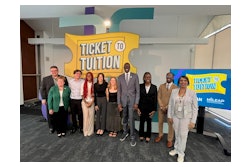The Evolution of a Texas HBCU
Now majority Hispanic, the historically black st. philip’s college has positioned itself to serve an increasingly diverse San Antonio population.
Though many smaller HBCUs are facing ongoing crises as funding and enrollment continue to dwindle, St. Philip’s College in San Antonio has found a way to thrive. Founded in 1898 by the Episcopal Church as a sewing school for Black girls, St. Philip’s has evolved into a comprehensive public community college with a for-credit enrollment exceeding 10,000.
Currently, Hispanics make up the largest ethnic group on campus, and St. Philip’s, part of the Alamo Community Colleges District, is now the only college to be federally designated as both a historically Black college and a Hispanic-serving institution.
“St. Philip’s evolved just to exist. It had to evolve,” says college archivist Mark Barnes. The college became co-ed in the early 1920s, and was classified as a Class-A junior college in 1927. At that point, Barnes says the college’s administrators realized that the school would have to be transformed from a private to a public institution, “because a lot of HBCUs were closing down because of lack of funding.”
Dr. Lanier E. Byrd, the recently retired vice president of academic affairs at the college, witnessed its transformation personally, first as a student and then during a 35-year career as a professor and administrator. Back in his student days, Byrd says the college was “99 percent Black.” But now, as “San Antonio’s population is largely Hispanic, the institution mirrors that population of the city. And St. Philip’s probably mirrors it more than any of the other sister colleges we have in our district.”
Maintaining a balance between the college’s HBCU roots and its current status as a predominately Hispanic school can be a challenge, as evidenced by discussion surrounding the appointment in March of a Black president, Dr. Adena W. Loston. Some of the college’s Hispanic constituents argued that it would have been natural to appoint a Hispanic president based on the current student demographics. Byrd, however, says San Antonio’s East Side is “probably the last stronghold of the Black community, with St. Philip’s in the middle of it.”
According to Byrd, some residents in the neighborhoods surrounding St. Philip’s argued that the college should have a Black president to “represent the African-American community and its rich history.”
Adds Loston: “The community absolutely felt that it should be an African-American. We have a 109-year history of that, and we have the designation of being a historically Black college. The community demands that kind of recognition from the administration. And so, rightly or wrongly, that is still something that the community holds dearly to, and they’re not willing to give up on it and recognize that the demographics have shifted.”
Being an HBCU and an HSI
Loston has hit the ground running, implementing a broad agenda aimed at boosting student recruitment and retention in part through a recovery program for high school dropouts. She says the program specifically targets minority dropouts in the surrounding community, thereby boosting both Hispanic and Black recruitment.
“The demographics of the state of Texas are such that we know that the fastest-growing population is Hispanics. So our goal is to seek to have a very aggressive program to attract both [Blacks and Hispanics], and then we also look at target populations of who’s absent,” Loston says. “We have a very strong and viable African American Male Initiative.”
Dr. Patricia Candia, the college’s vice president of student affairs, says the San Antonio community started to view St. Philip’s as serving more than solely Blacks in the early 1970s, when the college launched a number of allied health programs, including radiology, occupational therapy and respiratory and surgical technology.
“That’s when we started drawing citizens of the city to come to St. Philip’s because we were the only institution offering some of those programs,” Candia says. “So I think that also helped us have the city — the community — understand that we were providing a service for everyone, not just a selected group of individuals.”
The transition proved to be a smart move, as workforce training and allied health students now find themselves in demand from companies like Boeing and Swearingen Aircraft. And as demand has grown, so have salaries. Still, according to Byrd, the curriculum maintains a 55 percent to 45 percent balance between liberal arts and workforce training programs.
“It’s come full circle; people are now migrating back to the workforce area,” Byrd says, noting that many of the new graduates are Hispanics who he says “probably didn’t have a tradition of seeking higher education.”
When the college first launched its workforce training programs, Byrd says Blacks “didn’t have an option. If you were a minority, especially Black, you had to get into that.” But today, he says students are enrolling in the courses because they recognize that they can get their degrees or certifications faster and make more money.
Outside of the classroom, Candia says engaging the college’s Hispanic student population remains a challenge. Though Black student groups that existed when the student population was predominately Black are still thriving, “we’ve always had a challenge with getting our Hispanic student population active,” she says.
Kevin Schantz, who heads the college’s Service-Learning Program and the Student Leadership Institute, says it is critical that St. Philip’s stay true to its HBCU roots even as it evolves into an institution serving an increasingly Hispanic student body.
“There needs to be a balance between where we’ve been and where we’re going,” he says. “Being an HBCU and HSI — those don’t have to conflict with one another,” Schantz says. “They need to live harmoniously, and we need to be able to look at all of the population of the college together.”
— David Pluviose
There are currently 0 comments on this story.
Click here to post a comment.
© Copyright 2005 by DiverseEducation.com


















